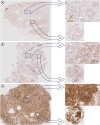FOLR1 as a therapeutic target in platinum-resistant ovarian carcinoma: unique expression patterns across ovarian carcinoma histotypes and molecular subtypes of low-grade serous carcinoma
- PMID: 40150910
- PMCID: PMC12426737
- DOI: 10.3802/jgo.2025.36.e74
FOLR1 as a therapeutic target in platinum-resistant ovarian carcinoma: unique expression patterns across ovarian carcinoma histotypes and molecular subtypes of low-grade serous carcinoma
Abstract
Objective: With the development of novel antibody-drug conjugates (ADCs), folate receptor alpha (FOLR1) is a promising therapeutic target for the treatment of platinum-resistant tubo-ovarian carcinomas. The main aims of this study were to assess FOLR1 protein expression in a large cohort of ovarian carcinoma histotypes. To inform future clinical trial design we identified molecular correlates of FOLR1 expression in low-grade serous carcinoma (LGSC).
Methods: One thousand five hundred forty-seven ovarian carcinoma samples from 5 different Canadian cohorts were successfully evaluated by immunohistochemistry for FOLR1 expression using the PS2+ system. Statistical analyses with clinicopathological parameters, LGSC molecular subtypes, and overall survival (OS) were performed.
Results: High FOLR1 expression was detected in 44% of high-grade serous carcinomas, and in 30% LGSC, 8% clear cell, 6% endometrioid, and 0% mucinous and/or mesonephric-type adenocarcinomas. In 160 LGSC cases, FOLR1 expression was more frequent in cases with normal MAPK pathway status (37% MAPK wild type vs. 14% canonical MAPK pathway mutations; p=0.002), low progesterone receptor (PR) expression (41%) vs. 23% (Allred score >2; p=0.02), and p16 loss (48% p16 absent vs. 26% normal; p=0.03). Canonical MAPK mutation status and PR expression remained significant on multivariable analysis. No significant associations between OS and FOLR1 expression were observed.
Conclusion: A significant proportion of LGSC express high FOLR1 levels supporting the development of clinical trials to investigate ADCs targeting FOLR1 as novel agents for treating this disease. In LGSC, high FOLR1 expression was associated with fewer MAPK pathway alterations, low PR expression, and p16 loss.
Keywords: FRa; Folate Receptor Alpha; Low-Grade Serous Carcinoma; Mirvetuximab Soravtansine; Molecular Subtypes; Ovarian Cancer.
© 2025. Asian Society of Gynecologic Oncology, Korean Society of Gynecologic Oncology, and Japan Society of Gynecologic Oncology.
Conflict of interest statement
Martin Köbel is consultant for Helix Biopharma, Stephanie Gaillard for Organon, Mark S. Carey is a consultant for Hexamer Therapeutics and holds securities in aiGene and Hexamer Therapeutics. All outside the scope of the submitted work.
Figures




References
-
- Slomovitz B, Gourley C, Carey MS, Malpica A, Shih IM, Huntsman D, et al. Low-grade serous ovarian cancer: state of the science. Gynecol Oncol. 2020;156:715–725. - PubMed
-
- Tsuchikama K, Anami Y, Ha SYY, Yamazaki CM. Exploring the next generation of antibody-drug conjugates. Nat Rev Clin Oncol. 2024;21:203–223. - PubMed
-
- Antony AC. Folate receptors. Annu Rev Nutr. 1996;16:501–521. - PubMed
MeSH terms
Substances
Grants and funding
LinkOut - more resources
Full Text Sources
Medical
Research Materials

